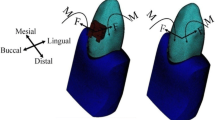Abstract
The aim of this paper is to quantitatively evaluating orthodontic force system during orthodontic treatment with a numerical method. Dental cast models were made to obtain digital models with impressions of a patient’s dental arch at regular intervals. Then the displacement of each bracket for a period of time was obtained by computer aided inspection. The finite element model of archwire in free status and brackets engaged in archwire was built. With the derived displacements applied as the boundary condition, the orthodontic force system at a time point was derived by a finite element analysis. The error of this method, especially the influences of friction and material of archwire on the orthodontic force system were discussed at last. This method can quantitatively evaluate the orthodontic force system generated from elastic material in clinic condition, the deformation history of archwire need to be traced for the orthodontic force generated from shape memory alloy.





Similar content being viewed by others
References
Geramy A (2000) Alveolar bone resorption and the center of resistance modification (3-D) analysis by means of the finite element method. Am J Orthod Dentofac Orthop 14(4):399–405
Iwasaki LR, Haack JE, Nickel JC, Morton, J (2000) Human tooth movement in response to continuous stress of low magnitude. Am J Orthod Dentofac Orthop 117:175–183.
Bergius M, Berggren U, Kiliaridis S (2002) Experience of pain during an orthodontic procedure. Eur J Oral Sci 110:92–98
Bergius M, Kiliaridis S, Berggren U (2000) Pain in orthodontics. A review and discussion of the literature. J Orofac Orthop 61:125–137
Fuck LM, Drescher D (2006) Force systems in the initial phase of orthodontic treatment—a comparison of different leveling archwires. J Orofac Orthop 67(1):6–18
Sifakakis I, Pandis N, Makou M, Eliades T, Bourauel C (2009) Forces and moments generated with various incisor intrusion systems on maxillary and mandibular anterior teeth [J]. Angle Orthod 79:928–933
Lapatki GB, Oliver P (2007) Smart brackets for 3D-force-moment measurements in orthodontic research and therapy—developmental status and prospects. J Orofac Orthop 68(5):377–396
Badawi HM, Toogood RW, Carey JPR et al. (2009) Three-dimensional orthodontic force measurements. Am J Orthod Dentofac Orthop 136(4):518–528
Ammar HH, Ngan P, Crout RJ et al. (2011) Three-dimensional modeling and finite element analysis in treatment planning for orthodontic tooth movement. Am J Orthod Dentofac Orthop 139:e59–e71
Burstone CJ, Koenig HA (1974) Force systems from an ideal arch. Am J Orthod 65:270–289
Burstone CJ, Koenig HA (1988) Creative wire bending—the force system from step and V bends. Am J Orthod Dentofac Orthop 93:59–67
Sang SJ, Baik HS, Moon YS, Yu HS, Cho YS (2003) A comparative evaluation of different compensating curves in the lingual and labial techniques using 3D FEM. Am J Orthod Dentofac Orthop 123:441–450
Kojima Y, Fukui H (2005) Numerical simulation of canine retraction by sliding mechanics. Am J Orthod Dentofac Orthop 127(5):542–551
Kojima Y, Fukui H (2006) A numerical simulation of tooth movement by wire bending. Am J Orthod Dentofac Orthop 130:452–459
Hayashia K, Arakib Y, Uechia J, Ohnoc H, Mizoguchia I (2002) A novel method for the three-dimensional (3-D) analysis of orthodontic tooth movement-calculation of rotation about and translation along the finite helical axis. J Biomech 35(1):45–51
Hayashi K, Tanaka H, Hikita K, Mizoguchi I (2004) Basic behavior of the finite helical axis in a simple tooth movement simulation. Med Eng Phys 26(10):867–872
Hayashia K, DeLongb R, Mizoguchia I (2006) Comparison of the finite helical axis and the rectangular coordinate system in representing orthodontic tooth movement. J Biomech 39(16):2925–2933
Clement R, Schneider J, Brambs HJ, Wunderlich A, Geiger M, Sander FG (2004) Quasi-automatic 3D finite element model generation for individual single-rooted teeth and periodontal ligament. Comput Methods Programs Biomed 73:135–144
Soncini M, Pietrabissa R (2002) Quantitative approach for the prediction of tooth movement during orthodontic treatment. Comput Methods Biomech Biomed Eng 5(5):361–368
Burton DS, Gao X, Brinson, LC (2006) Finite element simulation of a self-healing shape memory alloy composite. Mech Mater 38:525–537
Author information
Authors and Affiliations
Corresponding author
Rights and permissions
About this article
Cite this article
Wei, Z., Tang, W. & Wang, M. Evaluating orthodontic force system in clinical condition with a numerical method. Meccanica 48, 221–229 (2013). https://doi.org/10.1007/s11012-012-9596-4
Received:
Accepted:
Published:
Issue Date:
DOI: https://doi.org/10.1007/s11012-012-9596-4




